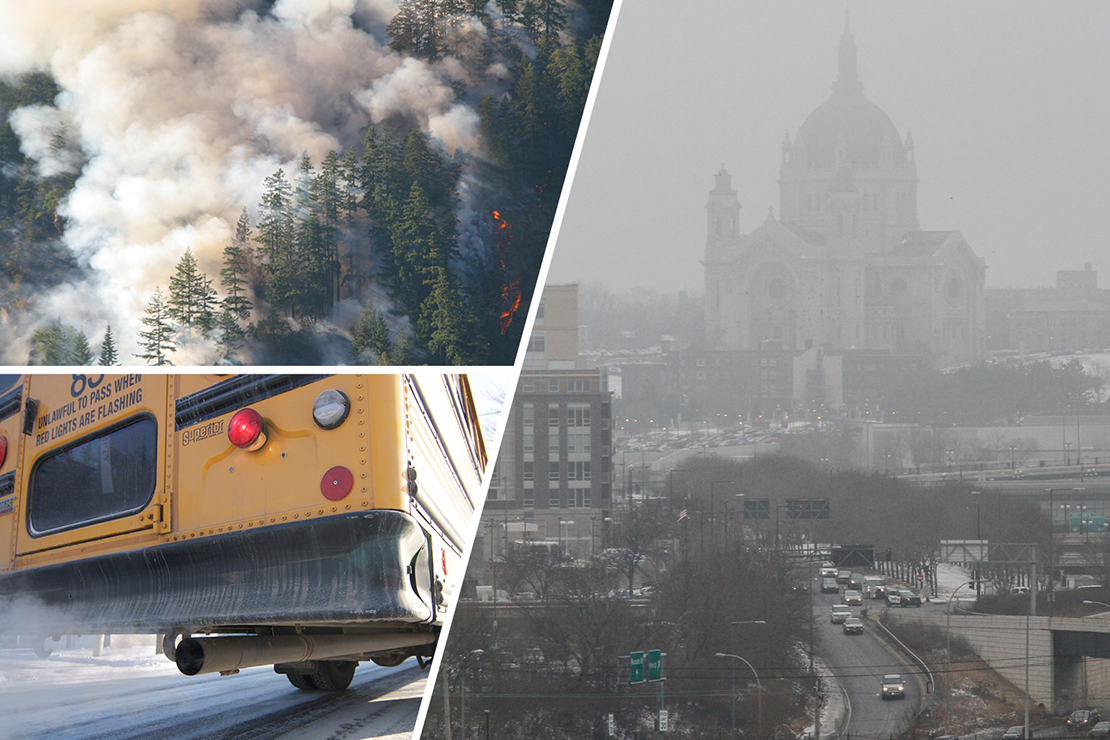The EPA plans to tighten air pollution standards, what it means for Minnesota

The U.S. Environmental Protection Agency (EPA) has proposed updated national ambient air quality standards for fine particle pollution, or PM 2.5, for the first time in more than a decade. The EPA says the proposed lower standards are driven by recent studies on the negative health impacts of exposure to particulate pollution. The particle pollution, or soot, is linked to asthma attacks, heart attacks, and premature deaths, and exposure is often higher in communities where people of color live and work.
Implementing the standard and ensuring local air quality meets the new levels is a joint effort by state, federal, and Tribal governments. Clean Air Minnesota has been a partner in these efforts for the past two decades by connecting smaller, often mobile, and more widespread sources of emissions — like small businesses, residences, diesel engines, and construction companies — with financial and technical resources to make voluntary upgrades. That work has made real air quality improvements for people living near projects and contributes to improved regional air quality, highlighting the importance of the work we’ve already done, and the work ahead of us.
The proposed changes would reduce one standard, which measures year-long average pollution concentrations, from 12 micrograms per cubic meter to a level between nine and 10 micrograms per cubic meter, which the agency says reflects the latest health data and research. The EPA proposed to maintain another standard, which is measured daily, at its current level. The EPA reviews these standards every five years, and they found that not all current standards are adequate for protecting public health. Minnesota’s air quality meets the current standards, a tribute to voluntary efforts like Clean Air Minnesota, but a more stringent standard motivates us to continue this important work. Clean Air Minnesota is co-chaired by the Minnesota Chamber of Commerce and the American Lung Association in Minnesota.
“The proposed PM 2.5 standard could cause Minnesota and other parts of the country to come out of compliance, resulting in significant regulatory and economic costs,” said Tony Kwilas, director of environmental policy for the Minnesota Chamber of Commerce. “It’s why collaborative, voluntary emission reduction projects and partnerships like Clean Air Minnesota are so important.”
Air pollution research has shown that lower particulate matter pollution is better for health. Finding opportunities to reduce emissions and exposures benefits public health and can also reduce disparities and potential impacts in communities with higher pollution concentrations. Studies examining pollution levels and local demographics have shown that policies that dictated where people of color could live and the siting of highways and pollution sources have led to disproportionate pollution exposures in those communities. Helping businesses and residents reduce their emissions helps alleviate the extra burden these communities face. Lower federal air quality standards will also push pollution concentrations down. Public health organizations argue for continued work on air quality improvement, even if an area meets the new standards. There are economic costs to negative health and environmental impacts, and the regulations associated with violating the federal standards would be an enormous burden on our regions’ businesses.
The American Lung Association said the proposed standards aren’t strong enough to protect people from the deadly pollutant. The changes will reduce premature deaths and illnesses from exposure, but thousands of additional lives could be saved if the standards were stronger, the Lung Association said in a press release. The Lung Association and the EPA’s scientific advisors pushed for the standard to be at eight micrograms per cubic meter, and the proposed standards fell short of that.
“Particulate matter is dangerous to human health. The particles settle deep in the lungs and can exasperate illnesses and lead to premature death. No level of it is safe, and it’s important we use all the tools in our toolbox to reduce as much of this pollution as we can,” said Jon Hunter, senior director of the Clean Air program at the American Lung Association in Minnesota.
Regardless of what the standard is and when it is implemented, Environmental Initiative will continue to work with public and private partners through Clean Air Minnesota to voluntarily reduce emissions. It’s work that will not be done until everyone breathes safe, clean air.
To learn more, sign up for Environmental Initiative’s quarterly Clean Air Minnesota newsletter.
Photographs of school bus tailpipe emissions and the Cathedral of Saint Paul, Minn. on a smoggy day courtesy of the Minnesota Pollution Control Agency.